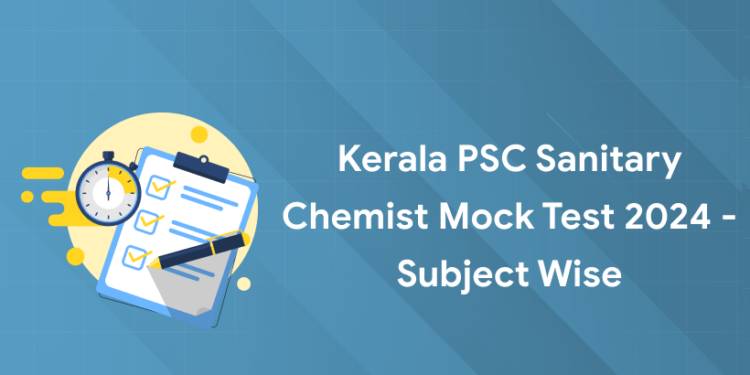Table of Contents
If you want to succeed in the competitive KPSC Sanitary Chemist examination, it’s essential to master the key concepts. In this blog, we have carefully designed a series of mock tests tailored to the Kerala PSC Sanitary Chemist exam 2024 syllabus. Whether you want to brush up on your knowledge or assess your understanding, these mock tests will be valuable resources to help you prepare. Let’s delve into the topics of microbiology, biochemistry, and chemistry that are crucial for success in the examination. Get ready for the Kerala PSC Sanitary Chemist Mock Test 2024. Access the free series now.
KERALA PSC SANITARY CHEMIST PREVIOUS YEAR QUESTION PAPER – FREE PDF
Kerala PSC Sanitary Chemist Recruitment 2024: Highlights
| Topics | Particulars |
| Organisations conducting recruitment exam | Kerala Public Service Commission (PSC) |
| Department for which recruitment is conducted | Kerala Water Authority |
| Type of recruitment | Direct Recruitment |
| Name of the job position | Sanitary Chemist |
| Category Number of post | 127/2023 |
| Vacancies listed in the notification | Will be updated after the exam |
| The official website of the organisation | keralapsc.gov.in |
| Application Mode | Online |
KERALA PSC SANITARY CHEMIST SYLLABUS 2024
Kerala PSC Sanitary Chemist Mock Test 2024 – Attempt Free Series Here!
1: Which Year First Assembly Election was held in Kerala?
Free Series: Kerala PSC Sanitary Chemist Mock Test 2024 – Dive into the Challenge!
| Mock Test Series | Link |
| Mock Test Paper – 1 | |
| Mock Test Paper – 2 | |
| Mock Test Paper – 3 | |
| Mock Test Paper – 4 | |
| Mock Test Paper – 5 | |
| Mock Test Paper – 6 |
Kerala PSC Sanitary Chemist Mock Test 2024 – Chemistry
Explore the chemistry-oriented mock test for the Sanitary Chemist position.
1. Which of the following household materials is NOT a surfactant?
- A) Soap
- B) Toothpaste
- C) Cooking gas
- D) Detergent
2. What is the primary function of preservatives in the food industry?
- A) Enhance flavor
- B) Increase shelf life
- C) Improve texture
- D) Add color
3. Which of the following is commonly used as an artificial sweetener?
- A) Aspartame
- B) Urea
- C) Superphosphate
- D) NPK
4. What is the main component of mothballs?
- A) Naphthalene
- B) Urea
- C) Ammonium nitrate
- D) Ethanol
5. Which fertilizer is known as “black gold”?
- A) Urea
- B) Superphosphate
- C) NPK
- D) Pesticides
6. Which pigment is commonly used as a white pigment in paints?
- A) ZnO (Zinc Oxide)
- B) Lithopone
- C) TiO2 (Titanium Dioxide)
- D) Blue pigment
7. What is the main component of plastics?
- A) Polystyrene
- B) Cellulose
- C) Monosaccharides
- D) Polymers
8. Which type of polymers are derived from natural sources?
- A) Thermoplastics
- B) Synthetic polymers
- C) Elastomers
- D) Natural polymers
9. Which of the following is NOT a problem associated with plastic waste management?
- A) Soil pollution
- B) Air pollution
- C) Marine pollution
- D) Deforestation
10. What is the chemical formula for urea?
- A) CH3OH
- B) NH4NO3
- C) CO(NH2)2
- D) H2SO4
11. Which of the following is a common blue pigment used in paints?
- A) Titanium dioxide
- B) Cobalt blue
- C) Cadmium red
- D) Carbon black
12. What is the main function of NPK fertilizers?
- A) Weed control
- B) Pest control
- C) Soil enrichment
- D) Nutrient supplementation
13. Which of the following is NOT a type of plastic?
- A) PVC
- B) PET
- C) NPK
- D) HDPE
14. What is the primary ingredient in toothpaste?
- A) Sodium chloride
- B) Fluoride
- C) Calcium carbonate
- D) Sulfuric acid
15. Which of the following is an example of a synthetic polymer?
- A) Cellulose
- B) Starch
- C) Polyethylene
- D) Rubber
Kerala PSC Sanitary Chemist Mock Test 2024 – Biochemistry
Below is a mock test tailored for the Sanitary Chemist role, with a focus on biochemistry topics:
1. What principle does Beer Lambert’s law describe?
- A) The relationship between absorbance and concentration of a solution
- B) The interaction of light with matter
- C) The separation of molecules based on charge
- D) The emission of light by excited molecules
2. Which chromatography technique relies on the principle of partitioning between a stationary phase and a mobile phase?
- A) Gel filtration chromatography
- B) Thin layer chromatography
- C) Column chromatography
- D) High-performance liquid chromatography (HPLC)
3. What is the principle behind the working of a colorimeter?
- A) Absorption of specific wavelengths of light by a sample
- B) Measurement of light intensity passing through a sample
- C) Generation of a spectrum of colors based on sample composition
- D) Separation of components based on charge and size
4. Which technique is commonly used for separating proteins and nucleic acids based on size and charge differences?
- A) Thin layer chromatography
- B) Gas chromatography
- C) Electrophoresis
- D) High-performance liquid chromatography (HPLC)
5. What is the primary application of spectrophotometry in biochemistry?
- A) Determination of molecular weight
- B) Separation of macromolecules
- C) Measurement of absorbance of specific wavelengths of light
- D) Visualization of cellular structures
6. Which unit is commonly used to measure radioactivity?
- A) Gram
- B) Kelvin
- C) Becquerel
- D) Pascal
7. What is the primary principle behind chromatography techniques?
- A) Electromagnetic induction
- B) Adsorption and partitioning
- C) Generation of an electrical gradient
- D) Ionization of molecules
8. What is the main purpose of SDS-PAGE in biochemistry?
- A) Determination of protein concentration
- B) Separation of proteins based on size
- C) Quantification of nucleic acids
- D) Identification of specific DNA sequences
9. What is the primary application of gas chromatography in biochemistry?
- A) Separation of nucleic acids
- B) Analysis of protein structure
- C) Quantification of metabolites
- D) Measurement of light absorbance
10. Which staining technique is commonly used in electrophoresis for visualizing nucleic acids?
- A) Coomassie Brilliant Blue
- B) Ethidium bromide
- C) Silver staining
- D) Crystal violet
11. What is the principle behind ultracentrifugation?
- A) Separation of molecules based on size and shape
- B) Separation of particles based on charge
- C) Generation of a density gradient
- D) Formation of a stationary phase and a mobile phase
12. What is the primary application of autoradiography in biochemistry?
- A) Determination of protein concentration
- B) Visualization of radioactive molecules in a sample
- C) Measurement of light absorbance
- D) Separation of macromolecules based on charge
13. Which type of chromatography relies on the specific binding between a ligand and its target molecule?
- A) Gel filtration chromatography
- B) Affinity chromatography
- C) Adsorption chromatography
- D) High-performance liquid chromatography (HPLC)
14. Which type of centrifugation is used to separate subcellular organelles?
- A) Preparative centrifugation
- B) Analytical centrifugation
- C) Differential centrifugation
- D) Ultracentrifugation
15. What is the primary function of a GM counter in radioactivity measurement?
- A) Detection of gamma rays
- B) Detection of alpha particles
- C) Detection of beta particles
- D) Measurement of light intensity
Kerala PSC Sanitary Chemist Mock Test 2024- Microbiology
Here’s a microbiology-focused mock test for the Sanitary Chemist position:
1. What is the main purpose of sterilization in microbiology?
- A) Enhancement of bacterial growth
- B) Elimination of all forms of microbial life
- C) Visualization of bacterial structures
- D) Selection of specific bacterial strains
2. Which staining method is commonly used to differentiate between Gram-positive and Gram-negative bacteria?
- A) Simple staining
- B) Acid-fast staining
- C) Gram staining
- D) Spore staining
3. What is the primary purpose of the GasPak jar in microbiology?
- A) Anaerobic culture
- B) Enrichment culture
- C) Selective culture
- D) Differential culture
4. Which type of culture media contains specific components that allow for the growth of certain microorganisms while inhibiting others?
- A) Solid media
- B) Semisolid media
- C) Selective media
- D) Differential media
5. Which staining method is used to visualize bacterial endospores?
- A) Simple staining
- B) Acid-fast staining
- C) Gram staining
- D) Spore staining
6. What is the primary purpose of enrichment culture media?
- A) Isolation of specific bacterial strains
- B) Visualization of bacterial structures
- C) Sterilization of bacterial cultures
- D) Destruction of bacterial cell walls
7. What is the primary principle behind spread plate culture methods?
- A) Even distribution of bacterial colonies on a solid medium
- B) Pouring molten agar into a Petri dish to solidify
- C) Anaerobic culture of microorganisms
- D) Growth of bacteria in a liquid medium
8. What is the main advantage of using differential culture media?
- A) Allows for the growth of specific microorganisms
- B) Provides nutrients for bacterial growth
- C) Differentiates between different types of microorganisms
- D) Inhibits the growth of unwanted bacteria
9. Which type of culture media contains known amounts of specific nutrients and is used for quantitative bacterial analysis?
- A) Solid media
- B) Semisolid media
- C) Liquid media
- D) Synthetic media
10. What is the primary function of chemical sterilization methods?
- A) Destruction of bacterial cell walls
- B) Inhibition of bacterial growth
- C) Elimination of all forms of microbial life
- D) Enhancement of bacterial growth
11. What is the main advantage of using the streak plate culture method?
- A) Provides isolated colonies for further study
- B) Allows for anaerobic culture of microorganisms
- C) Differentiates between different types of microorganisms
- D) Provides nutrients for bacterial growth
12. Which staining method is commonly used to visualize bacterial morphology and arrangement?
- A) Simple staining
- B) Acid-fast staining
- C) Gram staining
- D) Spore staining
13. What is the primary function of physical sterilization methods?
- A) Inhibition of bacterial growth
- B) Elimination of all forms of microbial life
- C) Enhancement of bacterial growth
- D) Destruction of bacterial cell walls
14. Which type of culture media contains a specific inhibitor to prevent the growth of unwanted bacteria?
- A) Enriched media
- B) Selective media
- C) Differential media
- D) Complex media
15. What is the primary principle behind the working of different types of microscopes?
- A) Visualization of bacterial structures
- B) Generation of an electrical gradient
- C) Magnification and resolution of images
- D) Separation of bacteria based on size
| Kerala PSC Sanitary Chemist Exam Information Links | |
| Kerala PSC Sanitary Chemist Assistant Notification | Kerala PSC Sanitary Chemist Mock Test |
| Kerala PSC Sanitary Chemist Syllabus | Kerala PSC Sanitary Chemist Video Course |
| Kerala PSC Sanitary Chemist Exam Date | Kerala PSC Sanitary Chemist Study Materials |
| Kerala PSC Sanitary Chemist Application Form | Kerala PSC Sanitary Chemist Interview Questions |
| Kerala PSC Sanitary Chemist Vacancy | Kerala PSC Sanitary Chemist Job Profile |
| Kerala PSC Sanitary Chemist Admit Card | Kerala PSC Sanitary Chemist Salary |
| Kerala PSC Sanitary Chemist Preparation Tips and Tricks | Kerala PSC Sanitary Chemist Study Plan |
| Kerala PSC Sanitary Chemist Best Books | Kerala PSC Sanitary Chemist Result |
| Kerala PSC Sanitary Chemist Eligibility Criteria | Kerala PSC Sanitary Chemist Cutoff |
| Kerala PSC Sanitary Chemist Selection Process | Kerala PSC Sanitary Chemist Exam Analysis |
| Kerala PSC Sanitary Chemist Answer Key | |












